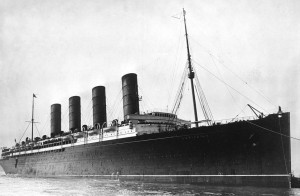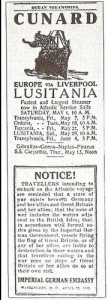Well, only a few days into the merry month of May and so much has happened.
We have see the birth of another great grandchild to Her Majesty The Queen and the Duke of Edinburgh, but that will have to wait for another blog. There has also been celebrations taking place for the end of the war in Europe – V E Day.
We have see the commemorations to those who lost their lives in the sinking of the Lusitania, 100 years ago and we have seen an election which I don’t think anyone predicted the outcome of. But enough of politics, so back to the Lusitania a more fitting subject for this blog.

RMS Lusitania – Wikipedia
She, RMS Lusitania was a British ocean liner and holder of the Blue Riband (an unofficial accolade given to passenger liners crossing the Atlantic at a record high speed – of 35 holders of the Blue Riband, 25 were British). She was launched on 7th of June 1906, becoming part of the Cunard Line. RMS Lusitania was the biggest passenger ship – for a short time. Built by John Brown & Co., at Clydebank, she weighed in at 44,060 tons. She had 9 passenger decks, provided approx. 50% more passenger capacity that any other ship at the time. The ship was equipped with lifts, electric lights, wireless telegraph and her first class accommodation and decks were magnificent in their furnishings.
The Lusitania left New York on the 1st of May 1915 for the port of Liverpool with 1962 people onboard including a crew of 850.

Advert from American papers – Wikipedia
By this time the German Government had declared that all Allied ships would be in danger of being attacked in British waters. Submarine activity was intensifying around the Atlantic making any vessel in our coastal waters a target for attack. It is said that the German Embassy in the United States placed an advertisement in newspapers warning passengers of the danger of being a passenger on the Lusitania.
On the 7th of May, RMS Lusitania, was off the coast of Ireland ready to complete her 202nd crossing and was due to dock in Liverpool later that afternoon. A course running parallel to the south coast of Ireland, and roughly 11 miles off the Old Head of Kinsale when the liner crossed in front of U-20 at 14:10hrs. The Commanding Officer of U-20, Schwieger, gave the order to fire one torpedo, which struck the Lusitania on the starboard bow – just beneath the wheelhouse. Shortly after, a second explosion came from within her hull, and the ship began to founder with a prominent list to starboard.
The crew rushed to launch the lifeboats but the position of the vessel and the conditions made their deploy quite difficult and in some cases almost impossible. As it was only six of the 48 boats were launched.
Eighteen minutes after the torpedo struck, the bow touched the seabed, with the stern still visible above the surface of the water – finally, sliding beneath the waves to her grave.
Of the 1962 passengers and crew on board the Lusitania 1,191 lost their lives, 405 members of the crew lost their lives including John Henry Lowrie Hayes .
The Lusitania had signalled her distress which brought Irish rescuers to the scene.
By the following morning the news if the sinking, of this unarmed passenger liner, had spread worldwide. Most of the passengers were either British of Canadians, there were 128 Americans on the passenger list who lost their lives and this outraged many in their country.
Dr. Bernhard Dernburg, a German spokesman published a statement saying that the Lusitania carried ‘contraband of war’ and also she was ‘classed as an auxiliary cruiser’ Germany had the right to destroy her regardless of any passengers on board. He also stated that because of the published warning in American papers that Germany were relieved of any responsibility for the deaths of the American citizens. He stated the ammunition and military goods listed as her cargo, which included an estimated 4,200,000 rounds of rifle cartridges, 1,250 empty shell cases and 18 cases of non-explosive fuses.
Cunard denied that she was carrying munitions but admitted her transportation of small-arms ammunition.
100 years later on the 7th of May 2015, Cunard’s MS Queen Victoria underook a voyage to the site of the sinking to lay a wreath to remember those who lost their lives on that day.
Previous commemorations had taken place, including a lifeboat crew rowing the 12 miles to the site of the disaster.
Like this:
Like Loading...







